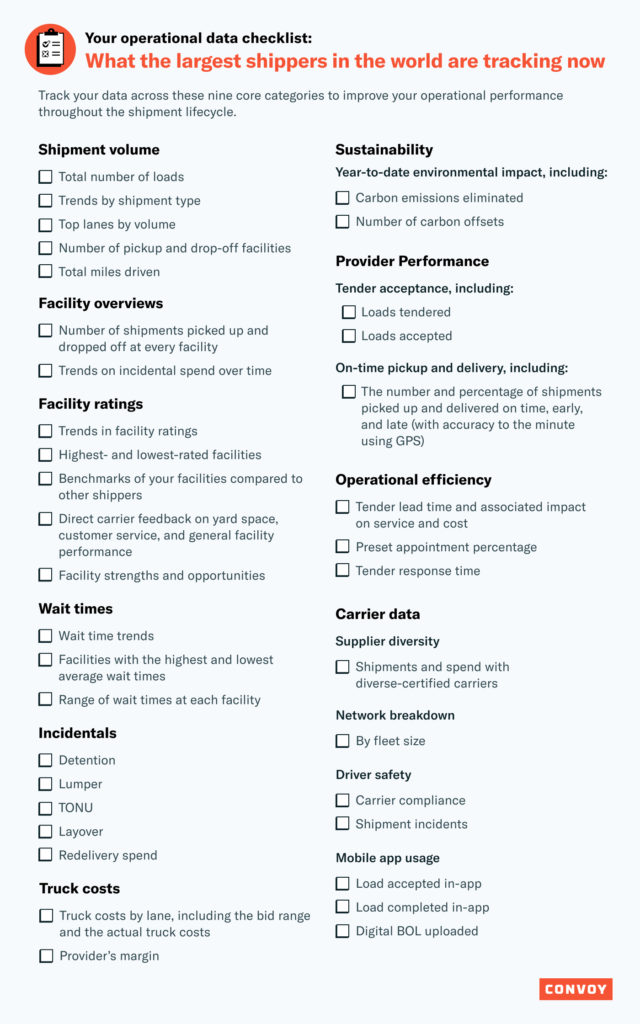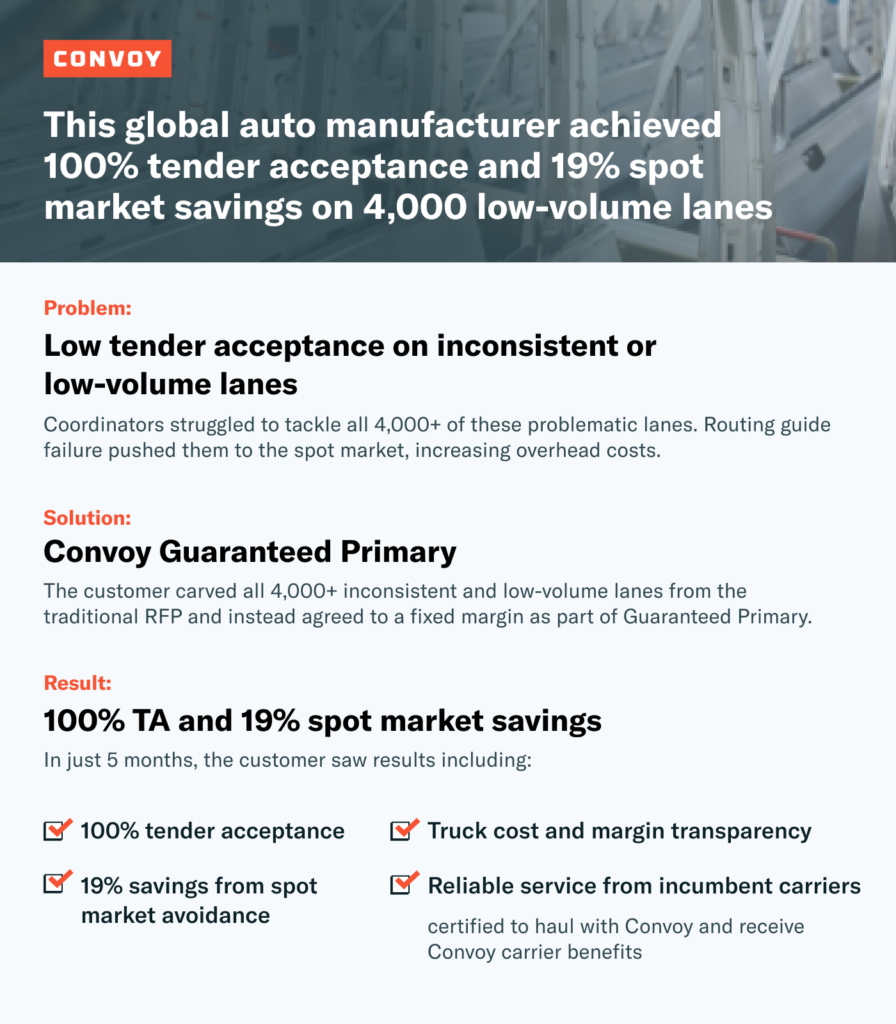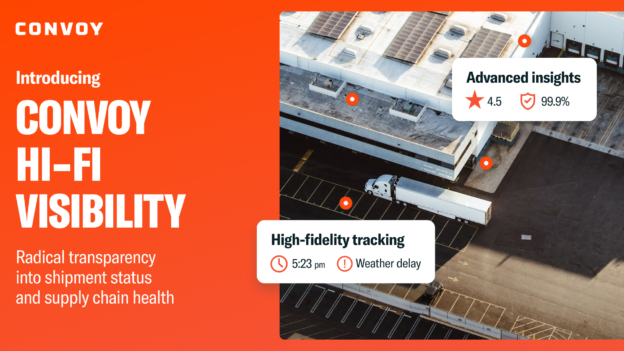Sick of the freight RFP? Here are 3 tools in your RFP toolbox to reduce the hassle
Shippers • Published on December 11, 2020
Life doesn’t always go according to plan. And neither do your freight contracts.
For decades, the annual freight RFP has been the juggernaut of transportation planning. And yet it’s no secret that the long and painful annual bid rarely works out as planned. Within six months, approximately 50% of all negotiated rates no longer apply.
Think back to last fall—to your bid for the 2020 season. Your team scoping your shipping volume and freight needs for the year, working through pricing and forecasting models, defining the RFP process itself, vetting hundreds of carrier applications, selecting freight partners.
Did those partners come through for you in 2020?
Was the time and cost to administer the RFP worth it?
2020 highlighted the fundamental flaws of the freight RFP—that it attempts to assert control and predictability in an unpredictable freight market.
“I’m so done with bids,” one of our customers said the other day. “They suck the life out of my team.” This is what we’re hearing from many shippers.
Alternatives to Traditional Freight RFP Process
As we wrap up the most volatile year in recent freight history, managing uncertainty and doing things differently are top of mind for many transportation teams.
Large and midsize shippers are looking for alternatives to the freight RFP, and companies like Convoy are introducing through new freight pricing programs like Guaranteed Primary, a new approach to sourcing primary freight that we launched in September.
Fixing the Traditional Freight Planning Tools: Bad News & Good News
Obviously the trucking industry didn’t get here overnight. System-wide, the complex network of shippers, brokers, and carriers simply simply hasn’t kept up with the technological innovations that have fundamentally altered how we work with each other.
Challenges of Traditional Freight Planning
Even though many shippers want to ditch the traditional RFP process, they can’t do it altogether. And it won’t happen overnight. It’s challenging to walk away from legacy systems and processes, and to win over internal stakeholders who are comfortable with the way things have always been done.
But as the saying goes, if you keep doing the same thing, you can’t expect a different outcome. And if 2020 has offered us anything, it’s permission to experiment and reassess.
Good News about Modern Contract Freight Tools
You can start to rewrite the rules of the traditional freight RFP process by using better tools to plan contract freight, some of which are already at your disposal. One of these is the contract freight planning tools in your freight RFP toolbox.
- Use this data checklist for for better budgeting and planning in 2021
- Test new alternatives to the traditional freight RFP
- Build trusted relationships with your strongest freight providers
The reality is, you will always have to work around volatile freight pricing within some portion of your shipping network, but the key is managing that uncertainty with the right mix of freight pricing tools, shipping providers, and market insights.
Checklist for better freight budgeting and planning in 2021
91% of executives say 2021 forecasting is going to look a lot different. Fortunately, you have the data and insights already in your toolbox to help you budget and plan for whatever comes your way. It’s just a matter of knowing what they all are. This data checklist can help.

Improve Supply Chain Visibility
Starting to track your supply chain shipment pricing data today will give you more supply chain visibility and a more resilient supply chain strategy for the future. Without accurate data and freight partners that can provide insights into the market, you won’t be empowered to make the decisions that improve your operating efficiency and drive down transportation costs.
Use Machine Learning to Digital Freight Networks
To give you an example of how this works, Convoy collects more than 1,000 data points on every shipment. We do this through our GPS-enabled mobile app that drivers use when hauling for Convoy. It collects data along every step of every shipment. These shipping network insights are delivered back to our shippers through detailed reports, online dashboards, and monthly business reviews. We also provide industry data based on aggregates across our nationwide network to establish baselines that help you understand your performance relative to other shippers.
More Dynamic Freight Pricing
With ongoing access to this data, your team will also be able to more quickly respond to changes in the market. That agility will better inform your transportation strategy, especially if you, like many other shippers, move away from the 12-month contract and tap into other tools in your toolbox.
Try out the alternatives to traditional freight RFP
Annual bids work best on lanes that see stable volume, when there’s confidence in the forecast. But as we’ve seen over the past several months, volumes—and lanes—are increasingly dynamic. This growing price unpredictability in freight RFPs process means annual budgets for freight procurement will increase while carrier reliability and quality capacity could potentially decrease.
Being Strategic with Freight Pricing
It’s time to think differently and be more strategic about the volatile and transactional freight in your network. Test new alternatives to the traditional freight RFP that address today’s volatility and give you confidence that you have the right tools in your toolbox.
Many of the innovative new freight programs are being offered by more recent entrants in the freight market, like digital freight networks.
These programs can be particularly effective for your inconsistent and low-volume lanes, since these pose a particular challenge: for shippers, they often require the highest overhead cost to service, and for carriers, the lack of volume commitment makes it challenging to provide consistent capacity.
Freight RFPs with 100% Tender Acceptance
One of these innovative new freight pricing programs is Guaranteed Primary, which shippers are using to get 100% tender acceptance at a low fixed margin without the annual contract commitment. Here’s how it worked for a global auto manufacturer:

Aside from programs like Guaranteed Primary, we’re seeing more and more shippers also running more frequent mini bids, which, though they do come with their challenges, offer shippers the chance to try new providers to see if they’d be interested in pursuing a more long-term relationship.
Your freight provider should always be looking for more creative capacity solutions on your behalf, like where there’s opportunity to convert spot freight to contracted freight. You could also reallocate volume from one provider to another to get more strategic coverage and balance your network.
Reduce Rejected Tenders
If now isn’t the right time to try these new approaches and you decide to stick with the traditional contract, make it a priority to supercharge your routing guide. Because the reality is, rejected tenders are going to pile up, if they aren’t already. And the best TMS integrations will act as your tender rejection safety net, giving you access to instant capacity, real-time dynamic freight pricing, and guaranteed shipping rates when you need coverage the most.
Build Relationships with a Network of Trusted Carriers
There’s a common misconception that having a large pool of carriers reduces the risk of supply chain disruption. The reality is that managing a large pool of carriers is often detrimental to the business.
Managing Multiple Carriers Increases Operational Costs
First, it’s expensive to manage many carriers, which drives up overall transportation spend. Shippers know their costs increase here, but they’re often okay with it because they think the cost savings are worth it. Specifically, they assume that pitting multiple carriers against each other on a lane will drive down rates. The opposite is often the case.
Give Enough Freight Density to Get Below-Market Rates
What really happens is that shippers don’t give their carriers enough volume to build supply-side freight density in order to drive any real pricing advantage. Supply freight density on a lane is critical to sourcing trucks cost-effectively. Without enough volume, carriers can’t perform well in this scenario. In fact, they can sometimes end up bidding on the same drivers, which increases cost to the shipper.
Think depth, not breadth. Build trusted relationships with your strongest freight providers and commit a healthy volume to them. This will enable them to source the best capacity on your lanes at below-market rates.
Picking Strongest Freight Providers
We’re seeing this trend pick up among transportation teams, with some cutting their networks by as much as half over the last year.
Which providers are the strongest? Ask yourself the following questions:
- Are they committed to innovating with you to solve your challenges? Have they put any investment behind that commitment?
- Do they challenge the way you’re doing things today and provide potential solutions, or do they simply accept the way things have always been done?
- Are they investing in technology to lower their costs over time?
- Do they offer transparency into their truck costs and margins to prove how well they buy transportation?
- Do they offer programs that create a win-win regardless of market conditions, saving you money when the market is soft and guaranteeing capacity when the market is tight?
- Do they offer you a complete look at your operational data and facility performance, along with market trends and freight economics research?
- Are they uniquely positioned to provide reliable, flexible capacity in any environment?
These questions have to do with innovation, transparency, trust, technology, resilience, partnership—all paramount in a reliable shipper-freight provider relationship that can weather any market.
If you answered no to any of these, it might be time to re-analyze your current relationships and consider new ones. And what’s a good way to do that? Well, you could try a mini bid—a tool already in your tool box.



